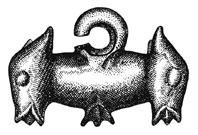

 | Page 1258 |  |
tradeware ceramics from China dating to the Song and Yuan dynasties (from the tenth through the fourteenth centuries a.d.) were found.
Archaeological work in the Tabon Caves has revealed more than 50,000 years of Philippine prehistory. The excavations of the caves were a boost to archaeology in the area and have contributed significantly to a better understanding of the prehistory of Southeast Asia and the Pacific region.

Jade ear pendant found in Duyong Cave
(Wilfredo P. Ronquillo)
See also
Island Southeast Asia; Philippines
References
Asato, S. 1990. “The Distribution of Shell Adzes in the South Ryuku Island, in the Urasoko Site: A Sketch of the Excavation in Photographs.” Gusukube Town Board of Education (Okinawa, Japan) March: 1–40.
Fox, R. B. 1966. “First Progress Report to the National Geographic Society on the Explorations and Excavations of Caves Sites of Ancient Man on Palawan Island, Philippines.” Unpublished manuscript. National Museum, Manila.
———. 1967. “Excavations in the Tabon Caves and Some Problems in Philippine Chronology.” In Studies in Philippine Archaeology (in Honor of H. Otley Beyer). Ed. Mario D. Zamora. Quezon City: Phoenix Press.
———. 1968. “Archaeology and the Philippines.” In Esso Silangan, XIII, (3). Ed. L. S. Vicente. Manila: Esso Standard Eastern.
———. 1970. The Tabon Caves. Monograph no. 1. Manila: National Museum.
(1885–1945)
Born in Ruovesi, finland, Aarne Tallgren was a professor of archaeology at the University of Tartu (Dorpat), Estonia, from 1920 to 1923, a professor of archaeology at the University of Helsinki from 1923 to 1945, chairman of the Finnish Society of Archaeology (later the Finnish Antiquarian Society) from 1930 to 1942, and a specialist in east European and north Asian prehistory. Tallgren was also the editor of Eurasia Septentrionalis Antiqua (published in Helsinki from 1926 to 1938, with a supplementary volume in 1954).
Tallgren can be regarded as the most renowned Finnish archaeologist of the twentieth century. His international fame was largely due to his achievements in the systematization and cultural synthesis of east European and Siberian Bronze Age and early Metal period materials and his involvement in the publication and editing of the journal Eurasia, a unique international forum for archaeological discussion in the interwar years.
In 1903 Tallgren enrolled at the University of Helsinki to study history and receive instruction in archaeology, which was not yet an official academic subject. Graduating in 1905, he continued his studies in Stockholm and Uppsala under oscar montelius and O. Almgren. Tallgren’s early research concerned the so-called Ural-Altaic Bronze Age as outlined by J. R. Aspelin, the founding figure of Finnish archaeology in the 1870s and 1880s. Aspelin’s Bronze Age was in fact ultimately related to the semiromantic quest for the prehistoric homeland of the “Finnish race”—the ancestors of the Finno-Ugrians—which had defined the orientation of early archaeological scholarship and prehistoric research in Finland. Tallgren reformulated the problems set out by Aspelin, pointing out that the assumed Ural-Altaic Bronze Age culture did not exist as a single entity; he stressed that the original ethnic interpretation had to be reconsidered.
Before the October Revolution, Tallgren visited russia in 1908, 1909, 1915, and 1917. (He
 |  |